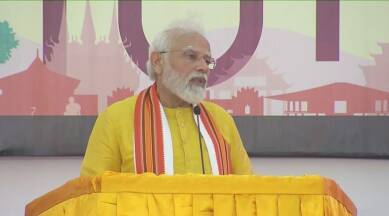
Modi’s Visit to Nepal to Strengthen Bilateral Ties
Manas Dasgupta
NEW DELHI, May 16: The Prime Minister Narendra Modi on Monday held bilateral talks with his Nepalese counterpart Sher Bahadur Deuba and visited Lumbini, the birthplace of Gautam Buddha, where the two leaders laid the foundation stone for the India International Centre for Buddhist Culture and Heritage in the Lumbini Monastic Zone. Modi was on a day’s visit to the Himalayan nation on the occasion of “Buddha Purnima.”
Once completed, the Centre will be a world-class facility welcoming pilgrims and tourists from all over the world to enjoy the essence of spiritual aspects of Buddhism.
In his address, Modi said “India and Nepal’s ever-strengthening friendship, in the kind of global conditions that are being created today, our closeness will serve the entire humanity. I know that today when a grand temple of Lord Shri Ram is being built in India, the people of Nepal are equally happy,” he added.
At their bilateral talks, Modi and Deuba discussed ways to strengthen ongoing cooperation and develop new areas in the multifaceted bilateral partnership. Six Memorandum of Understandings were signed by the two sides on cooperation in cultural and educational sectors. These included the construction of the Lumbini Museum in Nepal and the establishment of the Ambedkar Chair for Buddhist Studies in Lumbini Buddhist University
Earlier in the day, Modi prayed at Maya Devi temple in Lumbini, where he was accompanied by the Nepalese Prime Minister and his spouse Dr Arzu Rana Deuba. “I feel blessed to have prayed at the Maya Devi Temple on Buddha Purnima. May Lord Buddha bless us all and make our planet peaceful and prosperous,” Modi tweeted soon after.
The two Prime Ministers also lit lamps near the Ashoka Pillar adjacent to the temple. Erected by emperor Ashoka in 249 BC, the pillar bears the first epigraphic evidence of Lumbini being the birthplace of Lord Buddha.
This was Modi’s fifth visit to Nepal since 2014 but the first since the India-Nepal border row. Relations between the two countries were strained after Nepal’s previous K P Oli-led government issued a new political map in which it claimed disputed areas in the Kalapani region as its own.
“Taking forward our cultural ties. PM @narendramodi and PM @SherBDeuba perform Shilanyas ceremony of the India International Centre for Buddhist Culture & Heritage,” Ministry of External Affairs (MEA) Spokesperson Arindam Bagchi said on Twitter. “The centre is being built at the initiative of the International Buddhist Confederation, New Delhi,” he said.
The Centre will be a modern building, NetZero compliant in terms of energy, water and waste handling, and will house prayer halls, meditation centres, library, exhibition hall, cafeteria, offices and other amenities, the MEA said in a statement.
The Centre will be constructed by the International Buddhist Confederation (IBC), New Delhi, on a plot allocated to the IBC by the Lumbini Development Trust (LDT), under an agreement between the IBC and the LDT signed in March 2022, it said.
After the “shilanyas” ceremony, which was performed by monks belonging to three major Buddhist traditions, Theravada, Mahayana and Vajrayana, the two Prime Ministers also unveiled a model of the Centre, the MEA said.
“Beginning the Nepal visit with prayers at the sacred Maya Devi Temple, Lumbini,” the Prime Minister’s Office (PMO) tweeted. The leaders paid their respects at the Marker Stone inside the temple premises, which pinpoints the exact birth spot of Lord Buddha. They attended the pooja conducted as per Buddhist rituals, it said.
The two leaders also watered the Bodhi tree sapling from Bodh Gaya which was gifted by PM Modi to Lumbini in 2014 and also signed the temple’s visitor’s book. “A timeless bond of friendship… Prime Ministers @narendramodi and @SherBDeuba at the Maya Devi Temple in Lumbini,” the PMO tweeted along with a picture of Modi and his Nepalese counterpart Deuba watering the Bodhi tree sapling.
“Landed in Nepal. Happy to be among the wonderful people of Nepal on the special occasion of Buddha Purnima. Looking forward to the programmes in Lumbini,” Modi said on Twitter upon his arrival.
He was received by Deuba in Lumbini. “I would like to thank PM @SherBDeuba for the warm welcome in Lumbini,” Modi said in a tweet. Modi and his entourage arrived in Lumbini on a special Indian Air Force helicopter from Kushinagar, Uttar Pradesh. Lumbini, located in the Terai plains of southern Nepal, is one of the holiest places of Buddhism, as Lord Buddha was born there.
In a statement on Sunday, PM Modi said he was looking forward to meeting Nepalese Prime Minister Deuba again after their “productive” discussions during his visit to India last month. Both sides will continue to build on the shared understanding to expand cooperation in multiple areas, including in hydropower, development and connectivity, he said.
“Our ties with Nepal are unparalleled. The civilisational and people-to-people contacts between India and Nepal form the enduring edifice of our close relationship. “My visit is intended to celebrate and further deepen these time-honoured linkages that have been fostered through centuries and recorded in our long history of intermingling,” Modi said in his departure statement on Monday.
Nepal is important for India in the context of its overall strategic interests in the region, and the leaders of the two countries have often noted the age-old “Roti-Beti” relationship. The landlocked Himalayan nation shares a common border of over 1,850 kms with five Indian states – Sikkim, West Bengal, Bihar, Uttar Pradesh and Uttarakhand. Nepal relies heavily on India for the transportation of goods and services.













